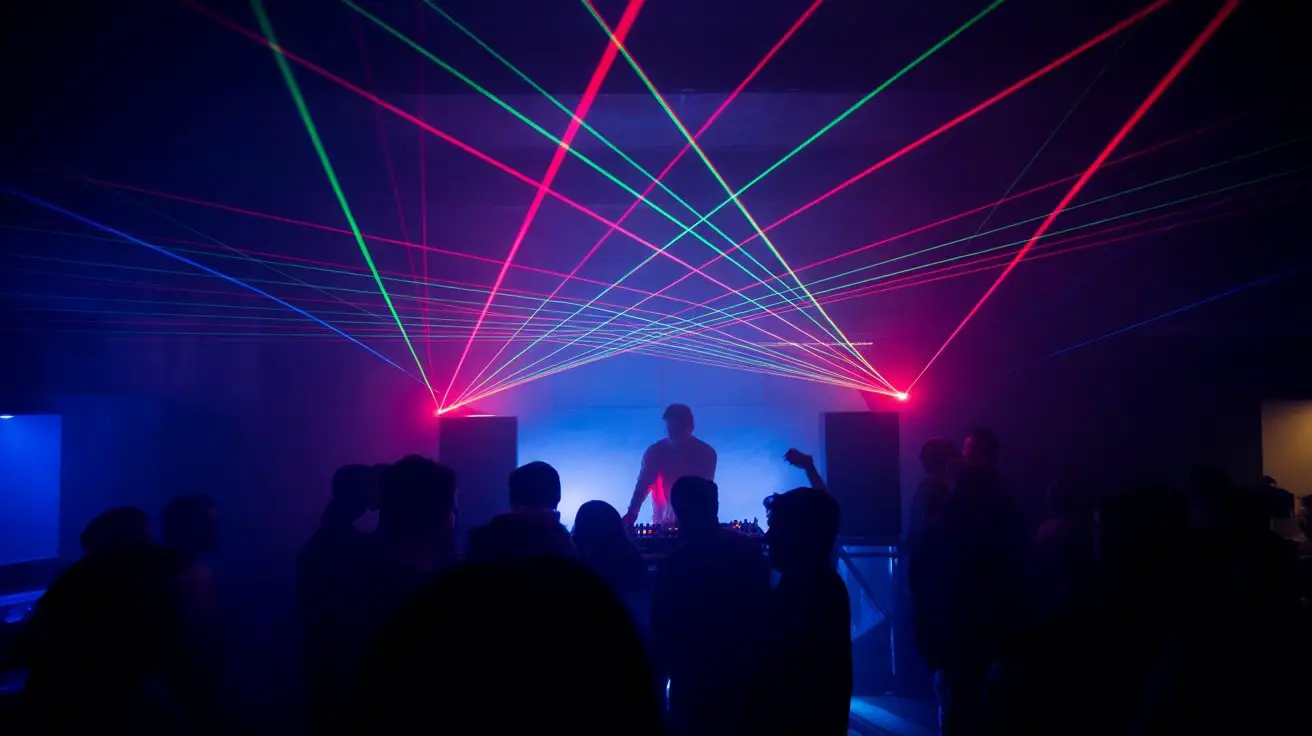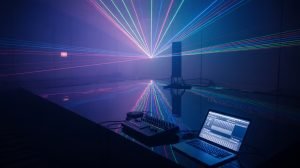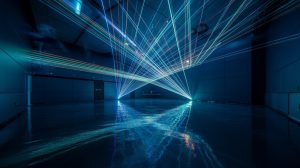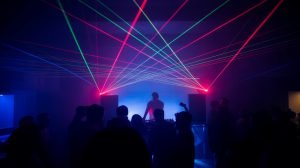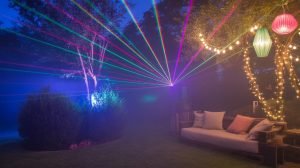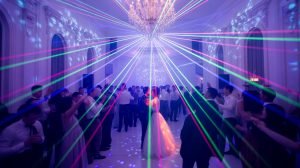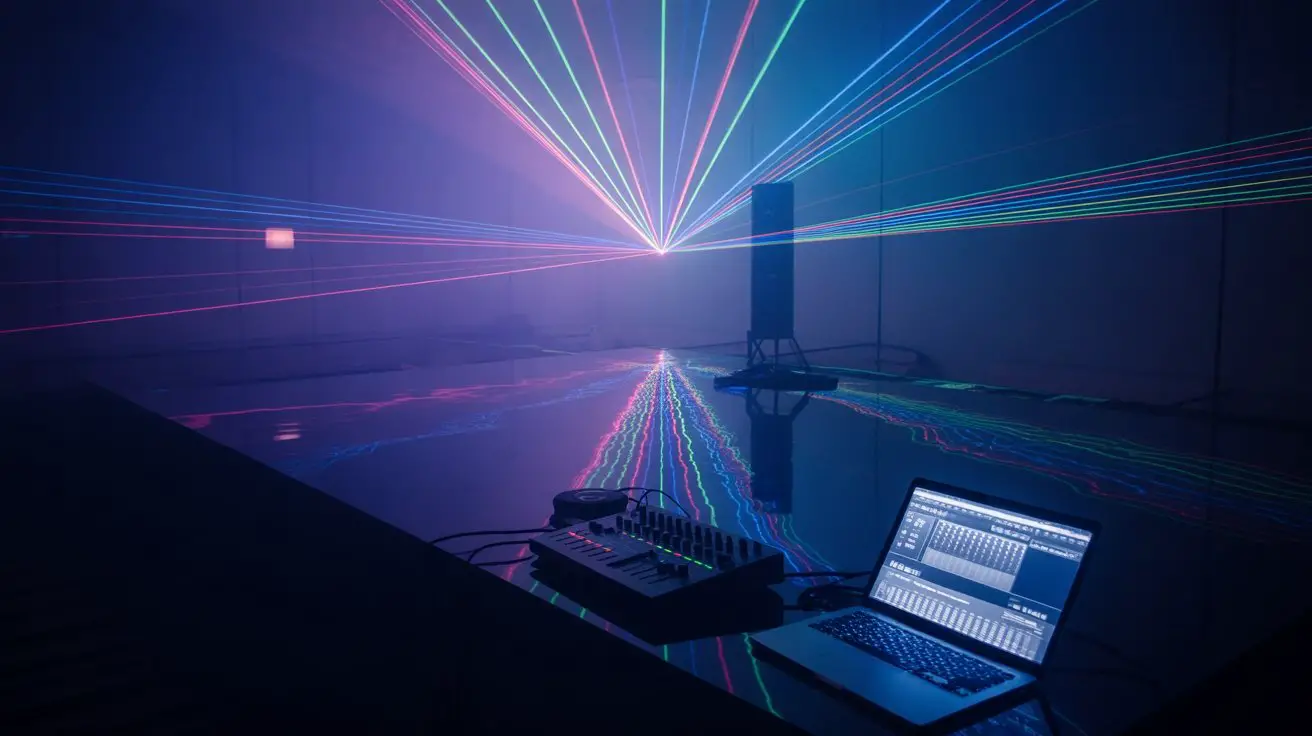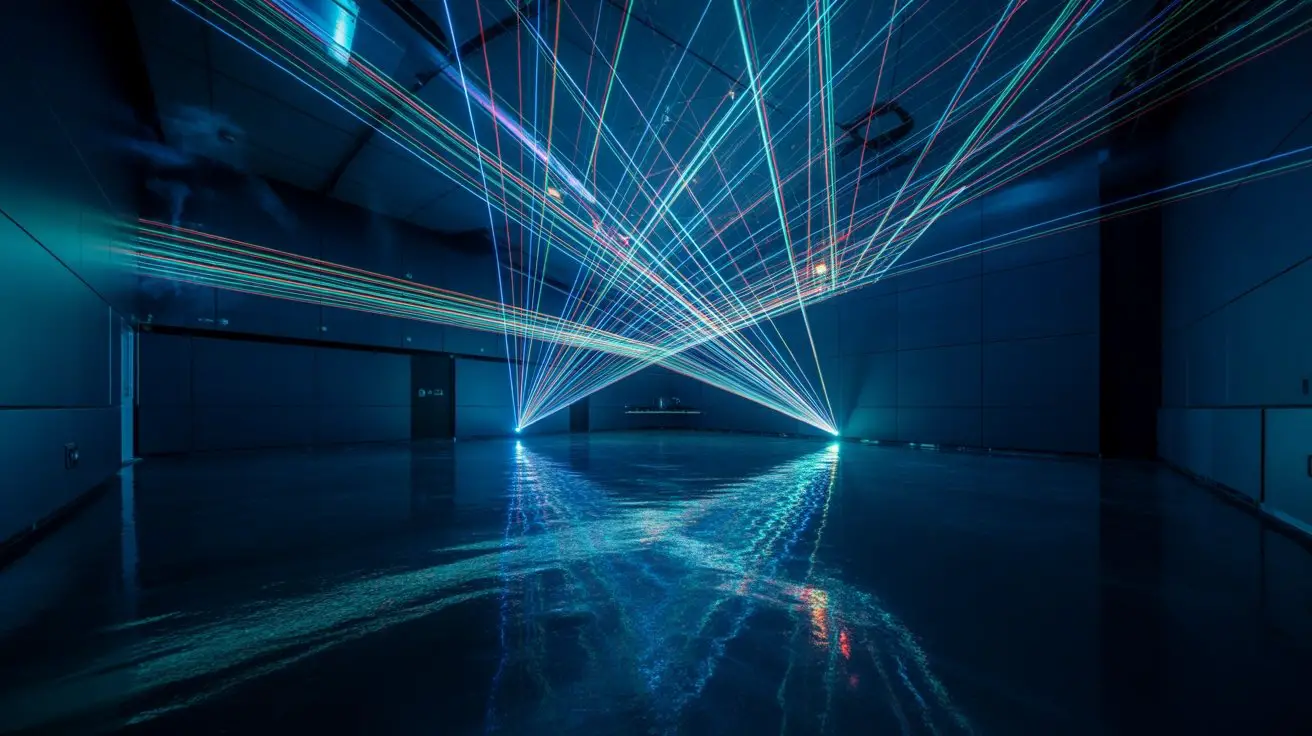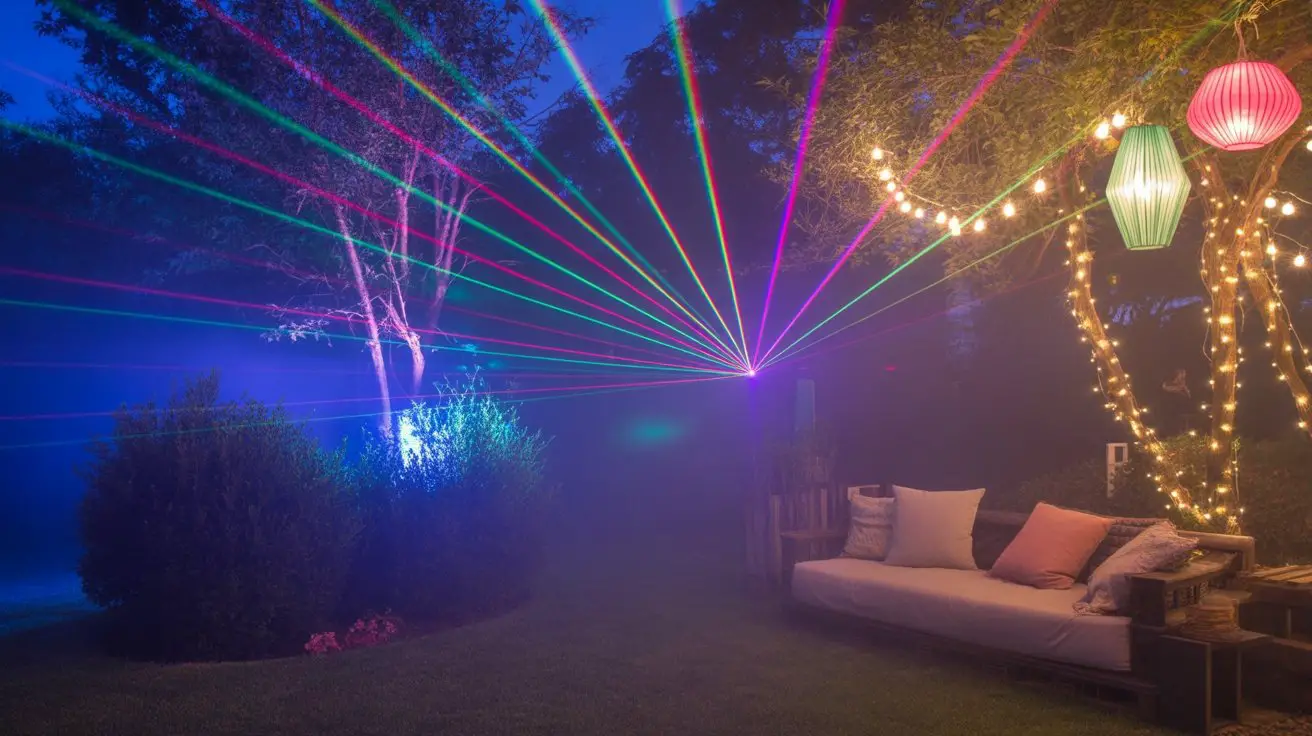When you’re spinning at a 200-capacity club with 8-foot ceilings, you’ll need compact laser projectors that won’t overwhelm your limited stage real estate. You can’t simply scale down arena-sized rigs—small venues demand specific beam angles, mounting configurations, and power outputs that match your spatial constraints. Your laser placement strategy becomes critical since improper positioning creates dead zones where your crowd won’t experience the full visual impact, potentially killing the energy you’ve worked to build.
Essential Laser Light Types for Compact Venues
Pattern projectors work exceptionally well for wall coverage when ceiling height’s restricted. Choose units with rotating gobos and variable zoom capabilities.
You can project intricate designs onto nearby surfaces, creating depth perception in cramped quarters.
Avoid high-powered scanning lasers exceeding 500mW in small venues—they’ll create dangerous reflection points and overpower your audience.
Instead, prioritize multi-diode arrays with individual color control. These provide versatility for subtle atmospheric effects during slower tracks and intense bursts during peak moments.
Always position units at performer eye-level to maximize beam visibility through crowd haze.
Budget-Friendly Laser Equipment for Starting DJs

When starting your DJ career, you’ll find entry-level laser units under $200 that deliver solid performance without breaking your budget. These beginner-friendly projectors typically feature RGB diodes producing 100-500mW output power, sufficient for small venues up to 1,500 square feet.
Look for units with DMX-512 compatibility and sound-activated modes. Entry-level models often include built-in microphones for auto-response functionality and master/slave capabilities for synchronized multi-unit setups.
| Feature | Budget Range ($50-$100) | Mid-Range ($100-$200) |
|---|---|---|
| Power Output | 100-200mW | 300-500mW |
| Pattern Count | 20-50 | 100+ |
| Control Methods | Sound/Auto | DMX + Sound/Auto |
| Beam Colors | Single/Dual | RGB Full Color |
Consider manufacturers like Chauvet DJ, ADJ, and Eliminator for reliable starter units with solid warranties and accessible replacement parts.
Setting Up Laser Systems in Limited Spaces

Since mobile DJs often work in cramped venues, you’ll need to maximize your laser coverage while minimizing equipment footprint.
Position compact laser units on elevated surfaces like speaker stands or ceiling mounts to avoid floor clutter. Use wide-angle projectors (60-90 degrees) for broader beam dispersion in tight quarters. Mount lasers at 8-10 feet height for ideal crowd coverage without direct eye exposure.
Deploy corner-mounting brackets to utilize unused wall space effectively. Choose fixtures with built-in mounting hardware rather than requiring separate stands. Consider truss-compatible units that integrate with existing lighting rigs.
Use sound-activated modes instead of DMX controllers to reduce cable runs and equipment complexity.
Stack multiple compact units vertically rather than spreading horizontally. This concentrates your laser array while preserving valuable floor real estate for dancing and equipment access.
Positioning Techniques for Maximum Visual Impact

Although laser placement height matters for safety, your positioning strategy determines whether beams create stunning aerial displays or disappoint audiences.
You’ll maximize visual impact by positioning units at mixed elevations – mount some projectors overhead while placing others at floor level to create intersecting beam patterns.
- Triangulate projector placement – Position three units in triangular formation to generate complex geometric patterns and eliminate dead zones in your coverage area.
- Utilize corner mounting – Install fixtures in venue corners to achieve maximum beam travel distance and create dramatic cross-venue sweeps.
- Stack vertical arrays – Mount multiple units at different heights on the same support structure to layer beam effects and increase pattern density.
Angle your projectors 15-30 degrees downward from horizontal to guarantee peak beam visibility through atmospheric haze while maintaining safe clearance above audience heads.
Synchronizing Laser Effects With Music Beats

Perfect laser positioning becomes meaningless without precise synchronization to your music’s rhythmic structure.
You’ll need DMX controllers with BPM detection capabilities or manual tap-sync functions to lock your laser effects to the beat. Configure your laser’s pulse width modulation to match kick drums, while reserving rapid-fire sequences for snare hits and hi-hats.
Most modern laser controllers offer automated beat-matching through audio input analysis. Set your strobe frequency between 1-4 Hz for ideal visual impact without triggering photosensitive reactions.
Program different chase patterns for verses versus choruses—subtle sweeps during vocal sections, explosive bursts during drops.
Use MIDI clock synchronization when running multiple laser units to maintain phase coherence. Always test your sync settings during soundcheck, as venue acoustics affect audio trigger sensitivity.
Manual override controls remain essential for live performance adjustments.
Safety Considerations and Venue Regulations

When operating laser equipment in performance venues, you’ll face strict regulatory compliance requirements that vary by jurisdiction and venue type. You must obtain proper permits, guarantee laser classifications meet safety standards, and maintain adequate beam termination.
Never direct Class 3B or Class 4 lasers toward audiences without proper safety interlocks.
- Power density calculations – Calculate maximum permissible exposure (MPE) limits based on wavelength, exposure duration, and beam divergence to prevent retinal damage.
- Emergency shutdown protocols – Install accessible kill switches and train venue staff on immediate laser system deactivation procedures during incidents.
- Beam path management – Position projectors above audience height, use beam stops, and avoid reflective surfaces that could redirect laser energy into crowd areas.
Most venues require insurance certificates and operator certifications before allowing laser installations.
Creating Dynamic Light Shows With Minimal Gear

Since budget constraints don’t have to limit your creative output, you can build compelling laser shows using entry-level equipment and strategic programming techniques.
Start with a single DMX-controlled laser projector featuring ILDA compatibility. Position it at 45-degree angles to maximize coverage across your venue’s dance floor. Use beam splitters and mirrors to create multiple projection points from one source.
Program chase sequences that synchronize with your track’s BPM using basic DMX software like QLC+ or Freestyler. Layer geometric patterns with color cycling to add visual depth.
Mount fog machines strategically to enhance beam visibility without overwhelming the space. Combine strobing effects with sustained patterns during build-ups and drops for maximum impact.
Troubleshooting Common Laser Light Issues

Although laser projectors deliver stunning visual effects, technical malfunctions can derail your performance if you don’t address them quickly.
You’ll encounter predictable issues that require immediate troubleshooting to maintain your show’s momentum.
- Beam intensity drops: Check power connections first, then inspect cooling vents for dust accumulation that causes overheating protection to activate.
- Pattern distortion occurs: Verify DMX cable integrity and controller signal strength, as interference disrupts galvanometer positioning accuracy.
- Color output fails: Examine individual laser diode functionality through built-in test modes, replacing faulty modules before your next gig.
Keep spare DMX cables, cleaning supplies, and basic tools accessible.
Monitor your laser’s temperature during extended sets, and always carry backup units for critical performances.
Quick diagnostics prevent minor glitches from becoming major failures.
Frequently Asked Questions
Can Laser Lights Damage Phone Cameras or Other Electronic Devices?
You’ll risk damaging phone cameras with direct laser exposure, especially high-powered units. CCD sensors are particularly vulnerable to permanent burn-in. Keep devices away from beam paths and don’t point lasers directly at electronics.
How Do Laser Effects Look Different in Venues With Mirrors or Windows?
Mirrors multiply and redirect your beam paths, creating infinite reflections that can overwhelm your venue. Windows scatter beams outside, reducing intensity while creating unwanted external projections. You’ll need lower power settings and careful positioning to control these reflective surfaces effectively.
What Backup Lighting Options Work if Laser Equipment Fails Mid-Event?
You’ll need backup strobes, LED pars, or moving heads ready to deploy. Keep spare fog machines running since atmospherics enhance any lighting. Pre-program backup scenes on your lighting controller for seamless shifts when lasers fail.
Do Certain Music Genres Work Better With Specific Laser Light Patterns?
You’ll find EDM responds well to fast geometric patterns and strobes, while ambient genres benefit from slow beam sweeps. Hip-hop works with sharp, angular movements, and rock suits aggressive chase sequences with your laser’s tempo-synced programming features.
How Far in Advance Should DJS Arrive to Test Laser Setups?
You’d think lasers are plug-and-play, right? Wrong. Arrive two hours early to calibrate beam angles, test DMX protocols, verify safety interlocks, and program cue sequences. Your crowd won’t forgive strobing malfunctions during peak drops.
Conclusion
You’re now the conductor of a digital orchestra, wielding lasers like luminous batons across your compact sonic cathedral. Your compact units serve as loyal soldiers, each DMX channel responding to your rhythmic commands. Through strategic positioning and beat-matching protocols, you’ve transformed cramped quarters into expansive visual territories. Remember: your laser arsenal’s only as powerful as your understanding of its circuitry. Master these photonic instruments, and you’ll command audiences like a technological wizard casting spells through synchronized light beams.

